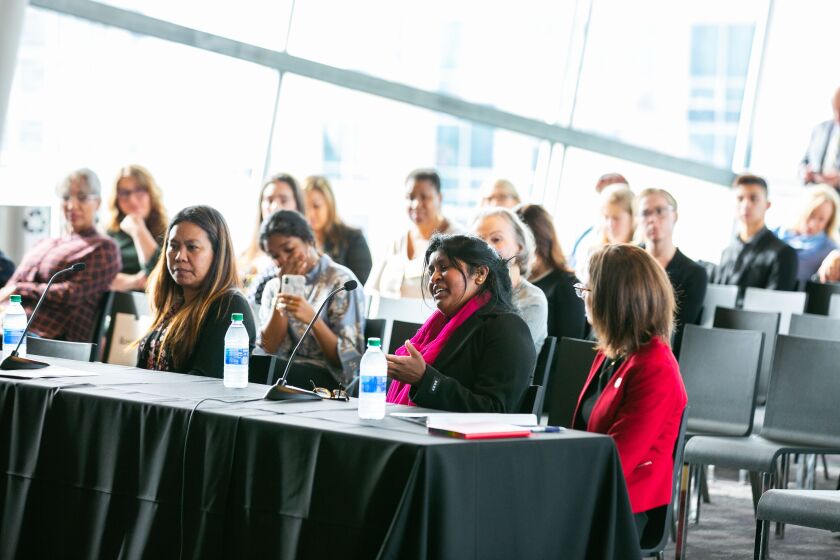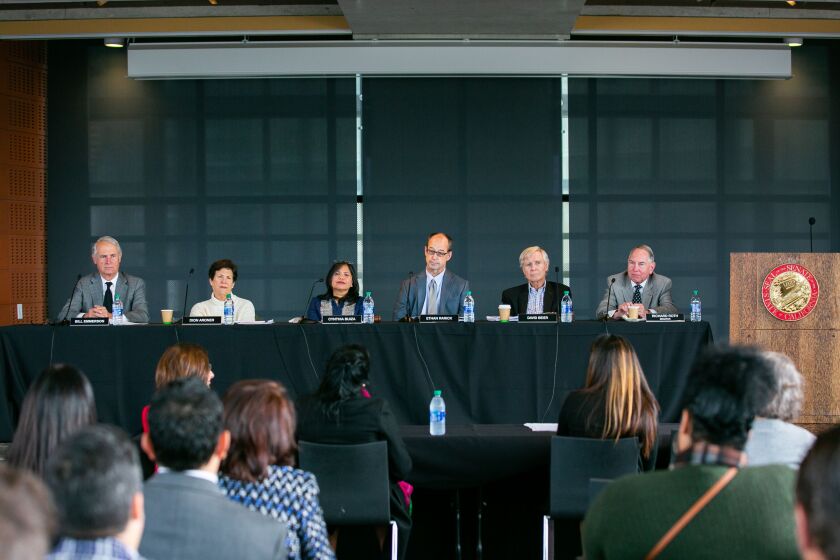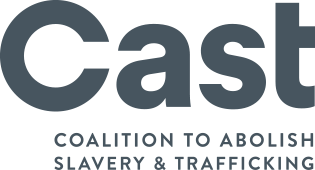
(PhotoArt by Valeria)
The Little Hoover Commission, California’s independent watchdog agency, is examining whether the state is adequately addressing labor trafficking, starting with a San Diego public hearing
SAN DIEGO —
Many mornings as caregiver Angela Guanzon would walk her elderly patients around the block, her neighbor would ask: “Don’t you ever get a day off?”
The question may have started out as a good-natured greeting, but it was soon tinged with concern.
So much so that the neighbor eventually called the FBI.
The full extent of Guanzon’s working conditions at the Long Beach elder-care facility soon came to light: 18-hour workdays, nights spent sleeping on hallway floors and threats of arrest if she ran away.
She was fortunate. The neighbor had noticed the nuances that most people ignored, and the suspicions unraveled a labor trafficking scheme that rescued Guanzon and others from indentured servitude.
Guanzon is emphatic that there are many, many more victims like her, working across a wide swath of industries, hidden in plain sight.
Yet they remain some of the toughest victims to identify.
The horrors of human trafficking have gained significant awareness across the country over the past decade — with a proliferation of legislation, task forces and outreach campaigns — although the bulk of the attention has focused on just one side of the issue: sex trafficking.
It’s an imbalance now being investigated by the state’s independent oversight agency.
The Little Hoover Commission has launched an effort to determine whether California is adequately addressing the needs of labor trafficking victims and will conclude with a report next year that will offer recommendations to the governor.
The commission started last month with an all-day public hearing in San Diego examining how prosecutors, social service providers and researchers have responded to the issue.
The response from witnesses was overwhelming: the resources to identify such victims, treat their trauma and bring their traffickers to justice are scarce, they said.
“We’ve come a long way, but we’re all working in our silos and we’re all stretched thin,” said Jamie Beck, an attorney who runs the nonprofit Free to Thrive, which provides pro bono legal services to trafficking survivors.

(PhotoArt by Valeria)
Comprehensive data measuring the scope of the problem is also lacking, although according to the Coalition to Abolish Slavery and Trafficking, the research that is available suggests labor trafficking makes up 39 percent of all human trafficking in California — not an insignificant amount.
Guanzon, the first to testify at the San Diego Central Library hearing on Nov. 21, set the tone with this observation: “Labor trafficking is not as simple as one might want it to be.”
Unlike sex trafficking victims, labor trafficking victims are almost exclusively foreign nationals. Some are in the U.S. without authorization, while others are lured to the U.S. with promises of legitimate work on valid visas, as was Guanzon.
Victims are trafficked in an array of industries, including agriculture, construction, janitorial, restaurant, domestic service, healthcare, carnivals, factories, nail salons and massage parlors.
They often don’t speak English, have no understanding of U.S. labor laws and live in constant fear that their opportunity to work and stay in the U.S. will be snatched away. So they endure the conditions.
“Labor trafficking victims are even more isolated from society than victims of sex trafficking,” said Beck.
Psychological manipulation and coercion are common, sometimes compounded by physical and sexual violence.
Guanzon, facing the prospect of being married off or jobless in the Philippines, thought she had won the lottery when she was recruited for the health care job in California. But upon arriving, her trafficker demanded $12,000 for the so-called opportunity, seized her passport and threatened to tell the police that Guanzon had stolen something if she ran away. Guanzon was ordered to work off the debt for 10 years, being paid $300 a month.
So cowed by the threats was Gaunzon that when the FBI first followed up on the neighbor’s tip and contacted her, she didn’t respond out of suspicion that it was her trafficker testing her.
The Urban Institute took a deeper look to understand the force, fraud and coercion used in labor trafficking, studying 122 cases nationwide.
The sample represented victims from 29 different countries, with Asia then Latin America represented most, according to the 2014 report. The split was roughly half male, half female, with 71 percent lawfully entering the U.S. on a temporary visa.
“Ninety-four percent knew they’d been victimized but blamed themselves for what they described as being ‘tricked,’” the study’s principal author, Colleen Owens, told the commission panel. “All lacked knowledge that what they were experiencing was labor trafficking and that they had rights in the U.S. regardless of their immigration status.”
Service providers emphasized the importance of outreach in vulnerable communities.
“These victims are not going to come forward,” Beck said. “We need to go to great lengths to identify them and connect them to services.”
But the outreach has to be on their terms — off site, in their languages, by their peers. Labor unions could help bridge that divide, they said.
San Diego County District Attorney Summer Stephan testified that it was with help from a janitorial watchdog group that the owners of a hotel cleaning business were prosecuted. “Using an on-the-ground advocacy group that culturally in every way was able to gain trust of the janitors and to talk to them about the conditions,” Stephan described.
But the business owners were not ultimately charged with the state’s labor trafficking laws, which Stephan described as too cumbersome and murky for both victims and a jury to understand.
Instead, prosecutors took an easier route, getting them on a $7 million insurance fraud and tax evasion scheme.
Prosecutors acknowledge that labor trafficking cases can be some of the most difficult to investigate due to a lack of law enforcement understanding surrounding the issue. “It’s often written off as an employment issue just like domestic violence was written off years ago as family issue,” said Nancy O’Malley, Alameda County’s district attorney.
But also because the traditional tools used in sex trafficking cases don’t seem to work for labor cases.
That’s why the San Diego Human Trafficking Task Force, comprising multiple agencies, is shifting to a financial focus — money laundering, insurance fraud, tax evasion.
“That’s the only way to shift that tide to make it very uncomfortable for greedy businesses and actors,” Stephan said.
A state law similar to the federal law that makes it illegal to withhold a person’s documents would also be a useful prosecutorial tool, Stephan said, as it’s easy to prove and common in such cases. It was recently vetoed as part of a larger legislative package but she hopes it will be reintroduced.
Because labor victims are often so distrustful of law enforcement — due to corruption in their homelands or their immigration statuses — witnesses proposed offering training for other public sector workers who might come into regular contact with victims, such as mail carriers, code compliance officers, health and food inspectors and animal services officers.
But one group that state and local authorities have remained reluctant to partner with are their federal counterparts. California’s so-called sanctuary state law prohibits interaction with federal authorities when it comes to immigration enforcement, and with labor trafficking so intimately intertwined with immigration, it can present a challenge.
Alamada County has a robust trafficking task force, but no feds are on it after two victims were deported, O’Malley said.
Kay Buck, chief executive officer of the Coalition to Abolish Slavery and Trafficking, or CAST, said the state needs to perhaps take a farther step back and examine whether there is implicit bias at play against foreign national workers.
“We need to admit we are simply as a state and country not serving immigrants well,” Buck said. “We need to pull back and ask why we’re not paying more attention to labor trafficking. This is the hundredth time I’ve been talking about labor trafficking and it’s not getting the attention it deserves.”
The Little Hoover Commission is planning a second public hearing in Sacramento next year.

